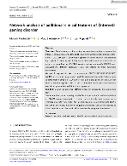| dc.contributor.author | Martoncik, Marcel | |
| dc.contributor.author | Adamkovič, Matúš | |
| dc.contributor.author | Ropovik, Ivan | |
| dc.date.accessioned | 2024-06-26T08:15:35Z | |
| dc.date.available | 2024-06-26T08:15:35Z | |
| dc.date.issued | 2024 | |
| dc.identifier.uri | https://hdl.handle.net/20.500.14178/2514 | |
| dc.description.abstract | ObjectivesThere are dozens of screening instruments purporting to measure the (Internet) gaming disorder (IGD/GD). The two prominent diagnostic manuals, DSM-5 and ICD-11, list several additional diagnostic or clinical features and problems (e.g., neglect of sleep, neglect of daily duties, health deterioration) that should co-occur or be caused by the IGD/GD. It remains unclear how specific IGD/GD operationalizations (different screening scales) are related to these functional impairments.MethodsTo explore this, data on six measures of IGD/GD (IGDS9-SF, GDSS, GDT, GAMES test, two self-assessments) and 18 additional diagnostic features were collected from a sample of 1009 players who play digital games at least 13 h per week. A network approach was utilized to determine which operationalization is most strongly associated with functional impairment.ResultsIn most of the networks, IGD/GD consistently emerged as the most central node.ConclusionThe similar centrality of IGD/GD, irrespective of its definition (DSM-5 or ICD-11) or operationalization, provides support for the valid comparison or synthesis of results from studies that used instruments coming from both DSM-5 and ICD-11 ontologies, but only if the goal is to evaluate IGD/GD relationships to other phenomena, not the relationships between the symptoms themselves. | en |
| dc.language.iso | en | |
| dc.relation.url | https://doi.org/10.1002/mpr.2021 | |
| dc.rights | Creative Commons Uveďte původ 4.0 International | cs |
| dc.rights | Creative Commons Attribution 4.0 International | en |
| dc.title | Network analysis of additional clinical features of (Internet) gaming disorder | en |
| dcterms.accessRights | openAccess | |
| dcterms.license | https://creativecommons.org/licenses/by/4.0/legalcode | |
| dc.date.updated | 2024-06-26T08:15:35Z | |
| dc.subject.keyword | diagnostic | en |
| dc.subject.keyword | functional impairment | en |
| dc.subject.keyword | gaming disorder | en |
| dc.subject.keyword | network analysis | en |
| dc.subject.keyword | network approach | en |
| dc.subject.keyword | | en |
| dc.identifier.eissn | 1557-0657 | |
| dc.relation.fundingReference | info:eu-repo/grantAgreement/MSM//LX22NPO5101 | |
| dc.relation.fundingReference | info:eu-repo/grantAgreement/MSM//PRIMUS/24/SSH/017 | |
| dc.date.embargoStartDate | 2024-06-26 | |
| dc.type.obd | 73 | |
| dc.type.version | info:eu-repo/semantics/publishedVersion | |
| dc.identifier.doi | 10.1002/mpr.2021 | |
| dc.identifier.utWos | 001231138800001 | |
| dc.identifier.eidScopus | 2-s2.0-85194407703 | |
| dc.identifier.obd | 648811 | |
| dc.identifier.pubmed | 38800951 | |
| dc.subject.rivPrimary | 30000::30300 | |
| dc.subject.rivSecondary | 50000::50100::50101 | |
| dc.subject.rivSecondary | 30000::30300::30312 | |
| dcterms.isPartOf.name | International Journal of Methods in Psychiatric Research | |
| dcterms.isPartOf.issn | 1049-8931 | |
| dcterms.isPartOf.journalYear | 2024 | |
| dcterms.isPartOf.journalVolume | 33 | |
| dcterms.isPartOf.journalIssue | 2 | |
| uk.faculty.primaryId | 117 | |
| uk.faculty.primaryName | Pedagogická fakulta | cs |
| uk.faculty.primaryName | Faculty of Education | en |
| uk.department.primaryId | 1584 | |
| uk.department.primaryName | Ústav výzkumu a rozvoje vzdělávání | cs |
| uk.department.primaryName | Institute for Research and Development in Education | en |
| dc.type.obdHierarchyCs | ČLÁNEK V ČASOPISU::článek v časopisu::původní článek | cs |
| dc.type.obdHierarchyEn | JOURNAL ARTICLE::journal article::original article | en |
| dc.type.obdHierarchyCode | 73::152::206 | en |
| uk.displayTitle | Network analysis of additional clinical features of (Internet) gaming disorder | en |

